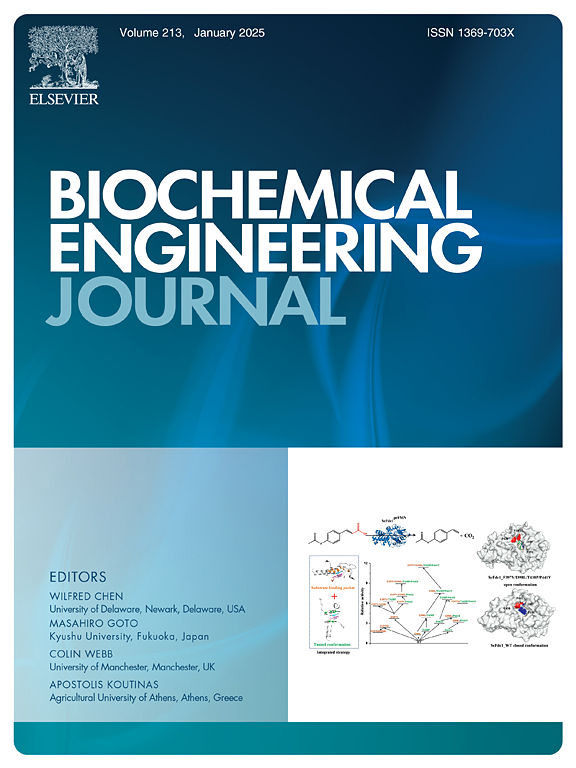Integrated waste-to-energy process for hazardous landfill leachate valorization: Economic profits related to sustainability and environmental assessment
IF 3.7
3区 生物学
Q2 BIOTECHNOLOGY & APPLIED MICROBIOLOGY
引用次数: 0
Abstract
While recent studies have presented hazardous landfill leachate (HLL) bio-digestion for biogas recovery, there is a research gap in enhancing the relative abundance of methanogens and managing the sludge digestate to avoid the risk of secondary pollution. This study represents the operation of an anaerobic digester amended with sawdust biochar to improve the HLL detoxification performance, followed by managing the sludge digestate to raise the project’s internal rate of return (IRR). This objective is justified by employing an integrated techno-financial and life cycle assessment (LCA) approach. Implementing the biochar-supplemented digester for HLL’s substrate conversion into biofuel achieved the shortest payback period (6.2 yr), considering biochar carbon credit (0.231 USD), biogenic gas selling (0.312 USD), biogas carbon marketing (0.118 USD), pollutant shadow price (0.064 USD), and digestate biochar selling (0.080 USD) per 1 m3. Increasing the Methanosaeta, Methylophilus, Paludibacter, Novosphingobium, and Pseudomonas relative abundances by 61.8 %, 529.3 %, 261.8 %, 25.9 %, and 100.0 %, respectively, enhanced the 2, 6-dichlorophenol dechlorination performance in the biochar-amendment digester. This project also maintained LCA endpoint impact categories of ![]() 6.05 × 10
6.05 × 10![]() 8 species·yr,
8 species·yr, ![]() 8.11 × 10
8.11 × 10![]() 5 DALYs, and 7.99 × 10
5 DALYs, and 7.99 × 10![]() 2 USD 2013 for ecosystem quality, human health, and natural resources, respectively. Because the proposed project would sustain an IRR of 9.7 %, and conserve terrestrial/aquatic ecosystems, future studies should focus on replacing fossil-based fuel with bio-CH4 to mitigate the effects of human-induced climate change.
2 USD 2013 for ecosystem quality, human health, and natural resources, respectively. Because the proposed project would sustain an IRR of 9.7 %, and conserve terrestrial/aquatic ecosystems, future studies should focus on replacing fossil-based fuel with bio-CH4 to mitigate the effects of human-induced climate change.
危险垃圾填埋场渗滤液增值的综合废物发电过程:与可持续性和环境评估有关的经济利润
虽然近年来已有研究提出利用有害垃圾渗滤液(HLL)进行生物消化以回收沼气,但在提高产甲烷菌的相对丰度和污泥消化管理以避免二次污染风险方面还存在研究空白。本研究通过木屑生物炭改性厌氧消化池的运行来提高HLL的解毒性能,然后对污泥消化池进行管理,以提高项目的内部收益率(IRR)。通过采用综合技术-财务和生命周期评估(LCA)方法来证明这一目标是合理的。考虑到生物炭碳信用(0.231美元)、生物气销售(0.312美元)、沼气碳营销(0.118美元)、污染物影子价格(0.064美元)和消化生物炭销售(0.080美元)/ 1 m3,采用生物炭补充沼气池将HLL的底物转化为生物燃料的投资回收期最短(6.2 yr)。将Methanosaeta、Methylophilus、Paludibacter、Novosphingobium和Pseudomonas的相对丰度分别提高61.8 %、529.3 %、261.8 %、25.9 %和100.0 %,可以提高生物炭改性沼池中2,6 -二氯酚的脱氯性能。本项目对生态系统质量、人类健康和自然资源的LCA端点影响类别分别为6.05 × 108个物种·年、8.11 × 105个DALYs和7.99 × 102 USD 2013。由于拟议的项目将维持9.7% %的IRR,并保护陆地/水生生态系统,未来的研究应侧重于用生物甲烷取代化石燃料,以减轻人为引起的气候变化的影响。
本文章由计算机程序翻译,如有差异,请以英文原文为准。
求助全文
约1分钟内获得全文
求助全文
来源期刊

Biochemical Engineering Journal
工程技术-工程:化工
CiteScore
7.10
自引率
5.10%
发文量
380
审稿时长
34 days
期刊介绍:
The Biochemical Engineering Journal aims to promote progress in the crucial chemical engineering aspects of the development of biological processes associated with everything from raw materials preparation to product recovery relevant to industries as diverse as medical/healthcare, industrial biotechnology, and environmental biotechnology.
The Journal welcomes full length original research papers, short communications, and review papers* in the following research fields:
Biocatalysis (enzyme or microbial) and biotransformations, including immobilized biocatalyst preparation and kinetics
Biosensors and Biodevices including biofabrication and novel fuel cell development
Bioseparations including scale-up and protein refolding/renaturation
Environmental Bioengineering including bioconversion, bioremediation, and microbial fuel cells
Bioreactor Systems including characterization, optimization and scale-up
Bioresources and Biorefinery Engineering including biomass conversion, biofuels, bioenergy, and optimization
Industrial Biotechnology including specialty chemicals, platform chemicals and neutraceuticals
Biomaterials and Tissue Engineering including bioartificial organs, cell encapsulation, and controlled release
Cell Culture Engineering (plant, animal or insect cells) including viral vectors, monoclonal antibodies, recombinant proteins, vaccines, and secondary metabolites
Cell Therapies and Stem Cells including pluripotent, mesenchymal and hematopoietic stem cells; immunotherapies; tissue-specific differentiation; and cryopreservation
Metabolic Engineering, Systems and Synthetic Biology including OMICS, bioinformatics, in silico biology, and metabolic flux analysis
Protein Engineering including enzyme engineering and directed evolution.
 求助内容:
求助内容: 应助结果提醒方式:
应助结果提醒方式:


